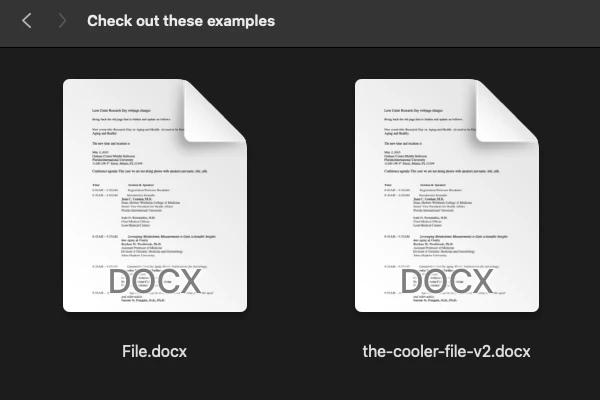Naming files properly is just as important as actually creating the files. After all, files are only useful if everyone can find them.
Instead of flooding your folder with files named document1.docx and FINAL.pdf, keep these best practices in mind to make sure your whole team is on the same page.
Create a system
The first thing you need to do is decide on a naming convention for your files. This provides a framework for your team, so everyone always knows what a specific file name means.
If you hold weekly meetings and need to keep a directory of notes, your directory might contain files that look something like this:
- 2025-02-01-meeting-notes.docx
- 2025-02-08-meeting-notes.docx
- 2025-02-15-meeting-notes.docx
The system above is easy to understand, formatted well and could be easily picked up by any new team member without confusion.
Only include important information
Depending on the context, you may include different information in a file's name to make its contents clear. Ask yourself if the file name contains content that is relevant, understandable and easy to find.
Relevant
What might be relevant in one context might be irrelevant in another. Meeting notes will probably require dates to be useful, while an evergreen handbook does not.
Understandable
Can the team members accessing the file understand its contents from the file name? Some abbreviations require additional information your users don't have. In that case, either revise your file name or provide that information to your users via training materials or other resources.
Easy to find
Folders can become bloated over time, so ensuring files contain keywords that are easy to find via search is vital. This ties back to creating a clear system of organization for your folders.
Multiple files? Use versions
It’s happened to all of us. We work on a big project, and suddenly, a folder has multiple files with names like Content.docx, ContentNEW.docx and ContentdocFINAL.docx.
Which one is the newest? The easiest way to make that clear is by including file versions in the name. Using the same examples from earlier, you can help your team by renaming:
- Content.docx into content-doc-v1.docx
- ContentNEW.docx into content-doc-v2.docx
- ContentFINAL.docx into content-doc-v3.docx
Use proper formatting
Different users can use different devices while working on the same project. For that reason, keeping your team consistent with their file name formatting should be a top priority.
Dashes, not spaces
Many file managers will not accept or properly read files that contain spaces in their names. Use dashes to separate information instead, ensuring wider access (and better SEO, as we noted in our UTM post).
If your team uses spaces, some applications may automatically replace spaces with other characters. Web browsers may insert percent symbols as indicators of blank spaces.
Avoid special characters
Special characters like exclamation points (!) and ampersands (&) can cause issues reading files on some devices. Some devices will outright prevent you from inputting special characters when naming files.
However, if your system allows it, you may accidentally create issues for other users. Some common special characters you may want to avoid are:
- Ampersands (&)
- Pound signs (#)
- Percent (%)
- Brackets []
- Asterisks (*)
- Question marks (?)
- Slashes (/ or \)
- Dollar signs ($)
Always type in lowercase
Lowercase file names reduce the risk of errors and make files easier to find without worrying about case sensitivity, which can vary from device to device.
Consistency is key
A filing system is only useful if your team is using it consistently! Consistency comes from good training, so make sure to have high-quality documentation and a plan for getting both existing team members and new hires up to speed with your system.
Your plan should account for:
- Which team members need to learn the system
- How they will learn the system (workshop, videos, documentation)
- Whether you are applying the system to older files (now may be a good time to review and delete outdated files)
- What new team members may need to integrate your best practices
Revise as needed
Whether it's in your office or the greater world of UX, there may be a reason in the future to change your filing system and its associated materials.
Here at DigiComm, we’re always improving our filing systems by incorporating user input like suggestions and feedback. Good information can come from anywhere.
Next steps
A high-quality file naming system is vital for collaboration. By taking a little time to reorganize your digital filing, you can help everyone on your team find what they need when they need it.
And of course, keep an open mind to ensure your system is always up to date with the latest best practices. Don't be afraid to take an idea and give it a quick Google search to see how it compares with current research and industry standards.
